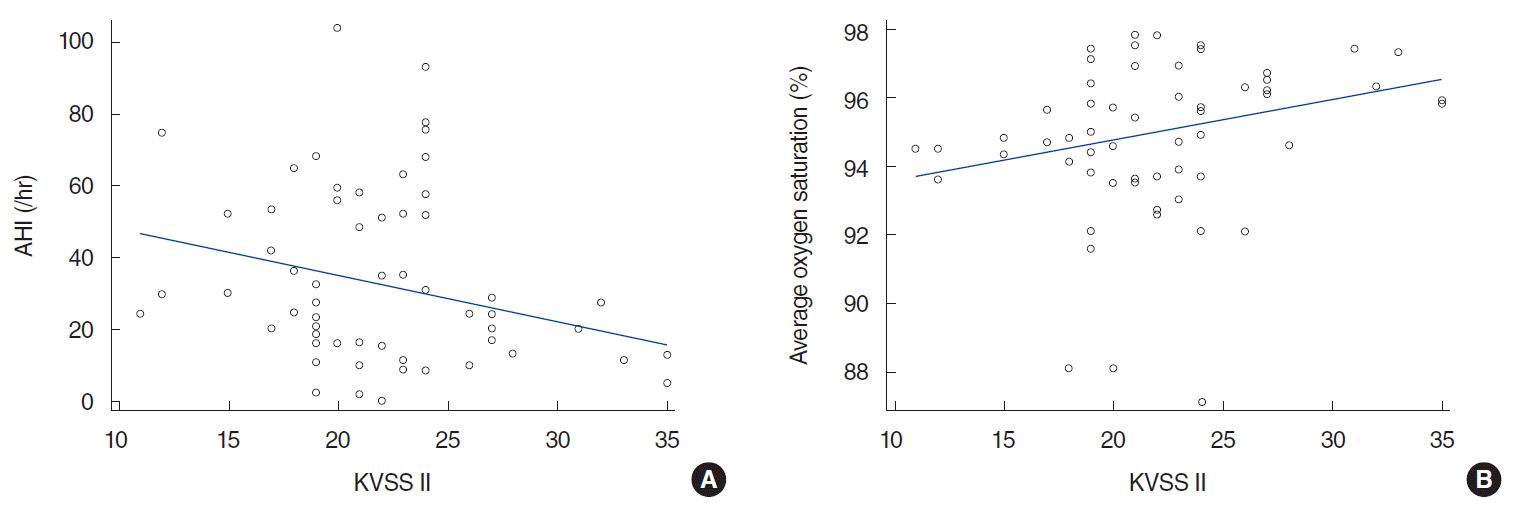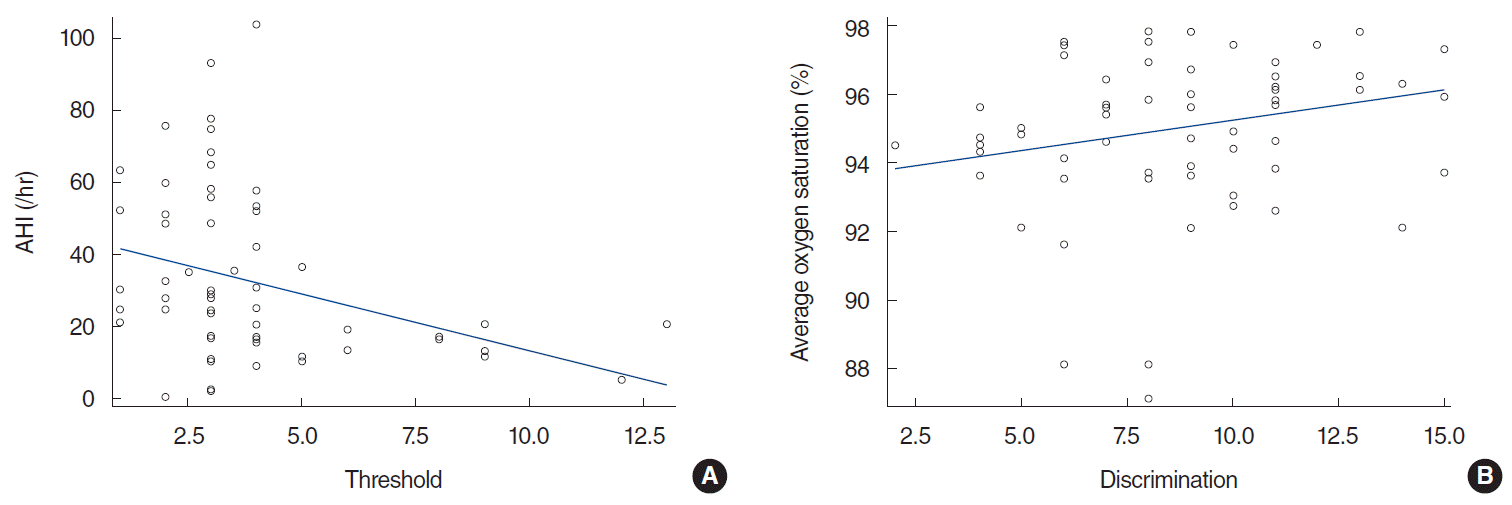1. Beebe DW, Gozal D. Obstructive sleep apnea and the prefrontal cortex: towards a comprehensive model linking nocturnal upper airway obstruction to daytime cognitive and behavioral deficits. J Sleep Res. 2002; Mar. 11(1):1–16.

2. Arruda-Olson AM, Olson LJ, Nehra A, Somers VK. Sleep apnea and cardiovascular disease: implications for understanding erectile dysfunction. Herz. 2003; Jun. 28(4):298–303.
3. Shin HW, Rha YC, Han DH, Chung S, Yoon IY, Rhee CS, et al. Erectile dysfunction and disease-specific quality of life in patients with obstructive sleep apnea. Int J Impot Res. 2008; Nov-Dec. 20(6):549–53.

4. Saboisky JP, Butler JE, Gandevia SC, Eckert DJ. Functional role of neural injury in obstructive sleep apnea. Front Neurol. 2012; Jun. 3:95.

5. Sunnergren O, Brostrom A, Svanborg E. Soft palate sensory neuropathy in the pathogenesis of obstructive sleep apnea. Laryngoscope. 2011; Feb. 121(2):451–6.

6. Dziewas R, Schilling M, Engel P, Boentert M, Hor H, Okegwo A, et al. Treatment for obstructive sleep apnoea: effect on peripheral nerve function. J Neurol Neurosurg Psychiatry. 2007; Mar. 78(3):295–7.

7. Jang HU, Park KS, Cheon SM, Lee HW, Kim SW, Lee SH, et al. Development of the korean version of the sleep apnea quality of life index. Clin Exp Otorhinolaryngol. 2014; Mar. 7(1):24–9.

8. Kang IG, Jung JH, Kim ST. The effect of obstructive sleep apnea on DNA damage and oxidative stress. Clin Exp Otorhinolaryngol. 2013; Jun. 6(2):68–72.

9. Gagnon K, Baril AA, Gagnon JF, Fortin M, Decary A, Lafond C, et al. Cognitive impairment in obstructive sleep apnea. Pathol Biol (Paris). 2014; Oct. 62(5):233–40.

10. Kielb SA, Ancoli-Israel S, Rebok GW, Spira AP. Cognition in obstructive sleep apnea-hypopnea syndrome (OSAS): current clinical knowledge and the impact of treatment. Neuromolecular Med. 2012; Sep. 14(3):180–93.

11. Croy I, Nordin S, Hummel T. Olfactory disorders and quality of life: an updated review. Chem Senses. 2014; Mar. 39(3):185–94.
12. Hedner M, Larsson M, Arnold N, Zucco GM, Hummel T. Cognitive factors in odor detection, odor discrimination, and odor identification tasks. J Clin Exp Neuropsychol. 2010; Dec. 32(10):1062–7.

13. Devanand Dp, Michaels-marston Ks, Liu X, Pelton Gh, Padilla M, Marder K, Et Al. Olfactory Deficits In Patients With Mild Cognitive Impairment Predict Alzheimer’s Disease At Follow-up. Am J Psychiatry. 2000; Sep. 157(9):1399–405.

14. Roberts RO, Christianson TJ, Kremers WK, Mielke MM, Machulda MM, Vassilaki M, et al. Association between olfactory dysfunction and amnestic mild cognitive impairment and alzheimer disease dementia. JAMA Neurol. 2016; Jan. 73(1):93–101.

15. Kirkpatrick MA, Combest W, Newton M, Teske Y, Cavendish J, McGee R, et al. Combining olfaction and cognition measures to screen for mild cognitive impairment. Neuropsychiatr Dis Treat. 2006; Dec. 2(4):565–70.

16. American Academy of Sleep Medicine. The international classification of sleep disorders. 2nd ed. Westchester, IL: American Academy of Sleep Medicine;2005.
17. Kim JM, Jeong MS, Shin DH, Seol JH, Hong SC, Cho JH, et al. Olfactory identification test using familiar distracters for Koreans. Clin Exp Otorhinolaryngol. 2014; Mar. 7(1):19–23.

18. Hong SM, Park IH, Kim KM, Shin JM, Lee HM. Relationship between the Korean version of the Sniffin’ stick test and the T&T olfactometer in the Korean population. Clin Exp Otorhinolaryngol. 2011; Dec. 4(4):184–7.
19. Cho JH, Jeong YS, Lee YJ, Hong SC, Yoon JH, Kim JK. The Korean version of the Sniffin’ stick (KVSS) test and its validity in comparison with the cross-cultural smell identification test (CC-SIT). Auris Nasus Larynx. 2009; Jun. 36(3):280–6.

20. Salihoglu M, Kendirli MT, Altundag A, Tekeli H, Saglam M, Cayonu M, et al. The effect of obstructive sleep apnea on olfactory functions. Laryngoscope. 2014; Sep. 124(9):2190–4.
21. Daurat A, Foret J, Bret-Dibat JL, Fureix C, Tiberge M. Spatial and temporal memories are affected by sleep fragmentation in obstructive sleep apnea syndrome. J Clin Exp Neuropsychol. 2008; Jan. 30(1):91–101.

22. Dulay Mf, Gesteland Rc, Shear Pk, Ritchey Pn, Frank Ra. Assessment Of The Influence Of Cognition And Cognitive Processing Speed On Three Tests Of Olfaction. J Clin Exp Neuropsychol. 2008; Apr. 30(3):327–37.

23. Eibenstein A, Fioretti AB, Lena C, Rosati N, Amabile G, Fusetti M. Modern psychophysical tests to assess olfactory function. Neurol Sci. 2005; Jul. 26(3):147–55.

24. Fu D, Pinto JM, Wang L, Chen G, Zhan X, Wei Y. The effect of nasal structure on olfactory function in patients with OSA. Eur Arch Otorhinolaryngol. 2015; Feb. 272(2):357–62.







 PDF
PDF Citation
Citation Print
Print


 XML Download
XML Download